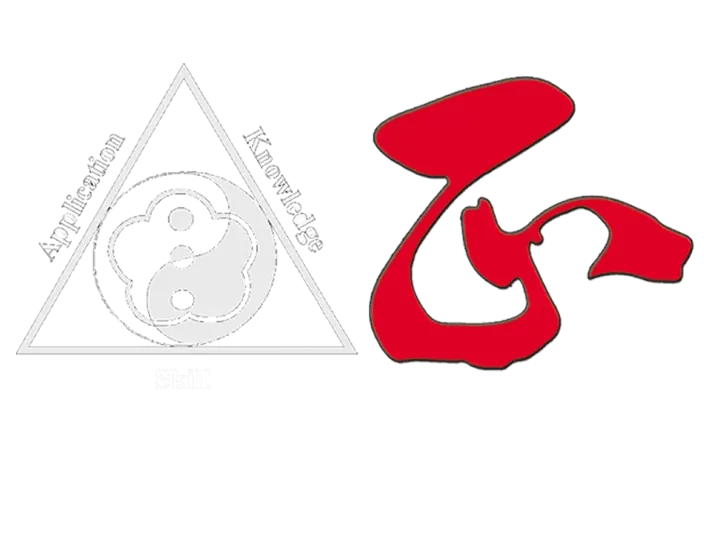Table of Contents
Choosing the Right Training Method For You
When it comes to training in Wing Chun Kung Fu, choosing the right method is crucial for maximizing skill development and progress. This article explores various training methods in Wing Chun, delving into their benefits and significance in the journey of mastering this dynamic martial art.
Traditional Training Methods
Traditional training methods in Wing Chun Kung Fu form the foundation of the art, preserving its authenticity and ensuring the continuity of its principles and techniques. These methods passed down through generations, focus on fundamental training exercises that develop essential skills, cultivate body mechanics, and foster a deep understanding of the art’s core principles.
One of the key traditional training methods in Wing Chun is the practice of forms. Forms, such as Siu Nim Tao, Chum Kiu, and Biu Tze, are a series of choreographed movements that encapsulate the principles and techniques of Wing Chun.
Practitioners perform these forms with a deliberate and focused approach, emphasizing correct body alignment, relaxation, and the generation of power through proper structure and technique.
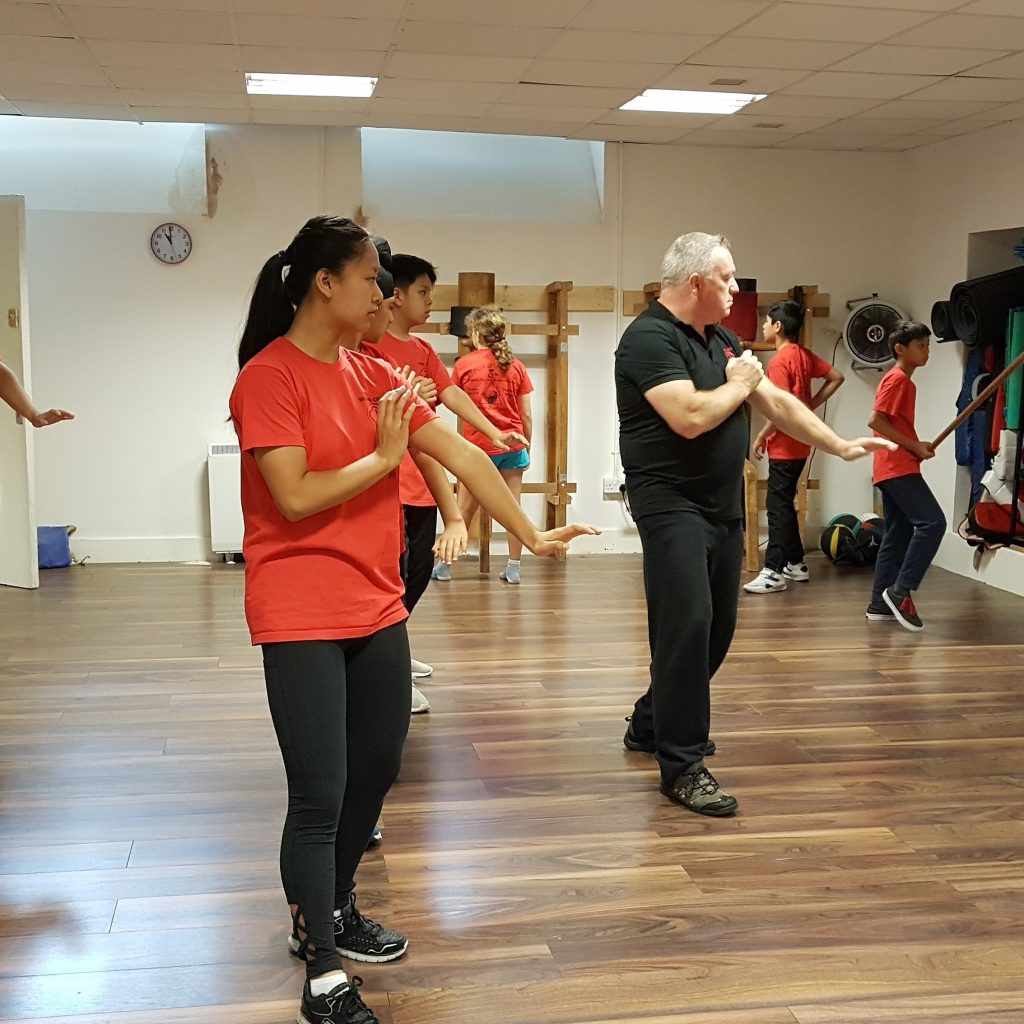
Forms training also facilitates the development of proper body mechanics and structure. The deliberate and controlled movements in the forms require practitioners to align their bodies, maintain a relaxed state, and coordinate the movement of various body parts.
This focus on body mechanics helps practitioners optimize their power generation, balance, and overall efficiency of movement.
Moreover, forms of training cultivate the mental aspect of Wing Chun. The repetition of the forms demands concentration, focus, and attention to detail.
Practitioners must engage both their bodies and mind to perform the movements accurately and with the correct intent. Through form practice, practitioners develop mental discipline, mindfulness, and a deeper connection to the art.
Another traditional training method in Wing Chun is Chi Sau, also known as sticky hands. Chi Sau involves close-range combat simulations where practitioners maintain contact with their training partner’s arms. This interactive training method hones sensitivity, reflexes, and adaptability.
By engaging in Chi Sau, practitioners develop the ability to read and respond to their opponent’s movements, improving their timing, control, and ability to flow in combat.
In addition to forms and Chi Sau, traditional training methods may also include drills and exercises that focus on specific aspects of Wing Chun techniques. These drills may involve footwork, striking, trapping, grappling, and application of techniques in various scenarios.
The repetitive nature of these drills helps refine technique, build muscle memory, and develop the practitioner’s ability to apply Wing Chun principles in practical situations.
Mastery of the art requires perseverance and a commitment to honing the foundational skills. Through the repetition and refinement of these traditional training methods, practitioners develop a solid foundation, allowing them to progress to more advanced techniques and concepts.
Forms training instills the fundamental movements, principles, and body mechanics of Wing Chun, while Chi Sau develops sensitivity, reflexes, and adaptability.
These traditional methods, along with drills and exercises, provide practitioners with a solid foundation and a deep understanding of the art’s core principles. By embracing and dedicating themselves to these traditional training methods, practitioners can progress in their Wing Chun journey, mastering the art’s techniques and philosophy.
Forms Training
Mastering the Fundamentals Forms training in Wing Chun Kung Fu is a cornerstone of the art, allowing practitioners to master the fundamentals, develop muscle memory, and cultivate a deep understanding of the principles and techniques.
The first and most fundamental form of Wing Chun is Siu Nim Tao, which translates to “Little Idea.” Siu Nim Tao serves as the foundation for all subsequent forms and techniques in Wing Chun.
Wing Chun focuses on cultivating proper body structure, balance, relaxation, and the development of energy flow, or “Chi.” Practitioners perform Siu Nim Tao with a deliberate and focused approach, paying attention to every detail of the movements.
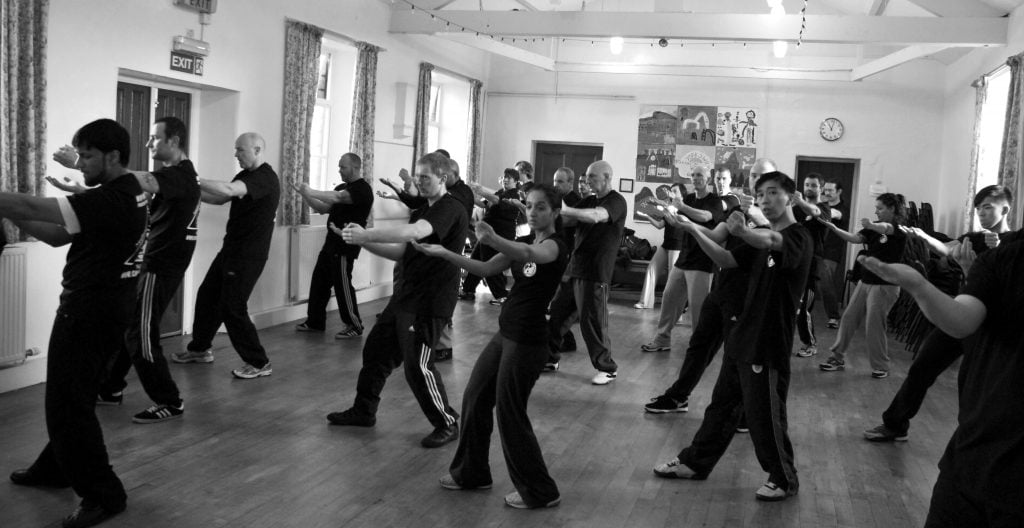
Through the diligent and consistent practice of Siu Nim Tao, practitioners develop a strong foundation in Wing Chun. The repetitive nature of the form allows practitioners to internalize the basic techniques and principles, leading to muscle memory and instinctual execution.
Proper execution of Siu Nim Tao’s movements promotes correct body alignment, relaxation, and the generation of power through the coordination of the whole body.
Chum Kiu, the second form of Wing Chun, builds upon the foundation laid by Siu Nim Tao. Chum Kiu focuses on the application of techniques in a mobile and dynamic manner. This form introduces footwork, shifting body weight, and coordination of upper and lower body movements. Practitioners learn to generate power from the ground, improve their mobility, and apply techniques in different directions and angles.
Biu Tze, the third form in Wing Chun, is an advanced form that further refines and expands upon the principles and techniques learned in Siu Nim Tao and Chum Kiu. Biu Tze incorporates more intricate and specialized techniques, including strikes, elbows, joint locks, and emergency techniques for close-quarters combat. It emphasizes explosive power, speed, and the ability to recover from compromised positions.
Forms training in Wing Chun goes beyond the physical execution of movements. It also cultivates mental discipline, focus, and mindfulness. Practitioners must engage their minds fully, paying attention to the subtleties of each movement, breathing pattern, and energy flow.
This mental aspect of forms training helps practitioners develop concentration, relaxation, and increased awareness of their body’s alignment and movements.
Furthermore, forms training provides a platform for self-reflection and self-correction. Practitioners can assess their technique, body alignment, and movement quality through form practice.
This self-analysis allows them to identify areas for improvement, refine their technique, and enhance their overall performance.
Forms training also plays a crucial role in developing sensitivity and the ability to adapt to different situations. Practitioners learn to flow smoothly from one technique to another, maintain constant contact and control, and adapt their movements based on their training partner’s energy and intent. This sensitivity and adaptability are fundamental skills in Wing Chun, enabling practitioners to respond effectively in real combat scenarios.
Forms training is a transformative journey that allows practitioners to deepen their understanding of Wing Chun and progress towards higher levels of mastery.
Chi Sau
Chi Sau, also known as sticky hands, is a dynamic and interactive method that plays a significant role in Wing Chun training. This practice focuses on developing sensitivity, reflexes, and adaptability, making it an essential component of a practitioner’s journey.
In Chi Sau training, practitioners engage in close-range combat simulations, where they make physical contact with their training partners. Through this tactile connection, Wing Chun practitioners learn to “stick” to their opponent’s arms, sensing and following their movements in real time.
The primary objective of Chi Sau is to maintain constant contact with the opponent’s arms while executing fluid and controlled movements. This allows the practitioner to intercept incoming attacks and respond with precise counterattacks, all while maintaining a balanced and centered position. By training in Chi Sau, practitioners develop lightning-fast reflexes, enabling them to react swiftly and instinctively to their opponent’s actions.
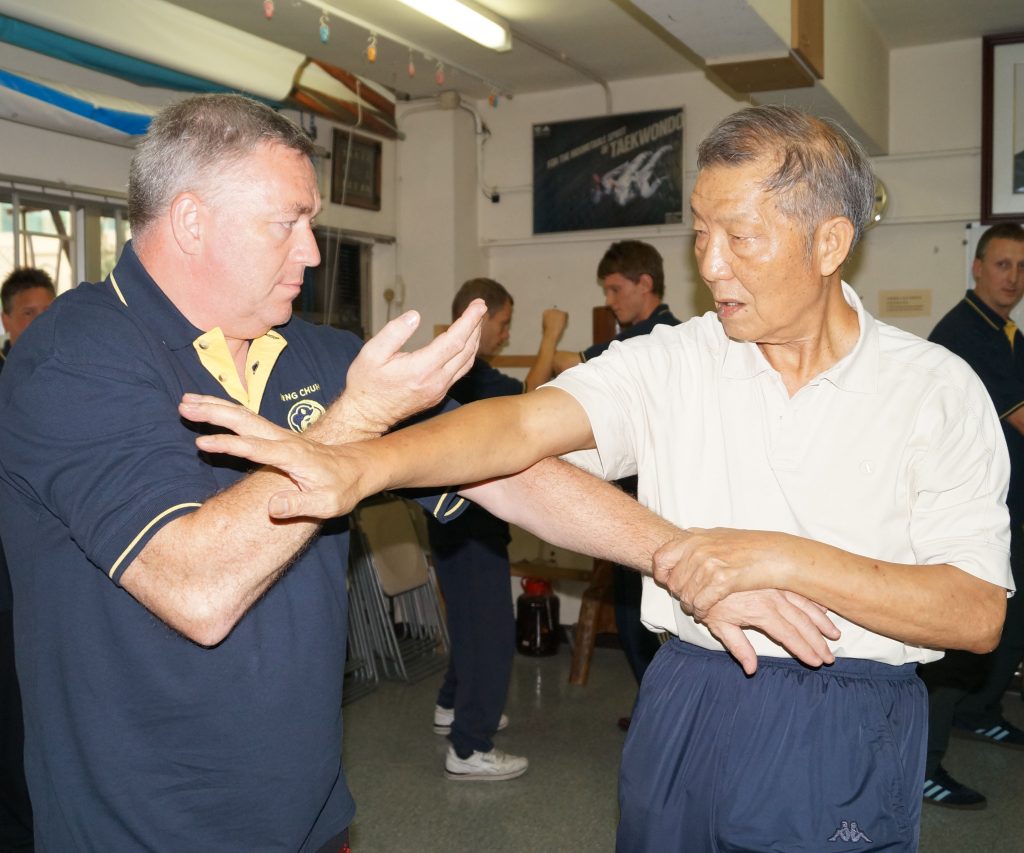
Chi Sau training serves multiple purposes in Wing Chun. Firstly, it hones the practitioner’s sensitivity to energy and pressure, fostering the ability to read and interpret an opponent’s movements before they fully manifest.
Chi Sau enhances a practitioner’s tactile and spatial awareness. Through repeated practice, the hands become attuned to the subtle shifts in pressure and positioning, enabling precise and accurate strikes and defenses.
This increased sensitivity extends beyond just the hands, permeating the entire body and enhancing overall body awareness and control.
Chi Sau is not limited to static drills but can also be practiced dynamically. Practitioners learn to flow seamlessly from one technique to another, adapting to the ever-changing circumstances of a fight.
This fluidity and adaptability, cultivated through Chi Sau training, allow practitioners to respond effectively to unexpected situations, maintaining control and dominance.
Moreover, Chi Sau fosters a deep level of trust and communication between training partners. As practitioners engage in close-quarters combat, they develop a sense of cooperation, relying on each other’s movements and energy to refine their techniques. This collaboration creates a unique bond among practitioners, fostering a supportive and challenging training environment.
Overall, Chi Sau is a vital training method in Wing Chun Kung Fu, as it enhances sensitivity, reflexes, adaptability, and overall combat effectiveness.
Wooden Dummy Training
Wooden Dummy training, also known as Mook Jong, is a cornerstone of Wing Chun Kung Fu, providing practitioners with a dedicated tool to refine their techniques, develop precision, and deepen their understanding of the art’s applications. The wooden dummy is a specially designed apparatus consisting of a central wooden body, arms, and legs that simulate an opponent.
This unique training method offers numerous benefits and is integral to the progression of Wing Chun practitioners.
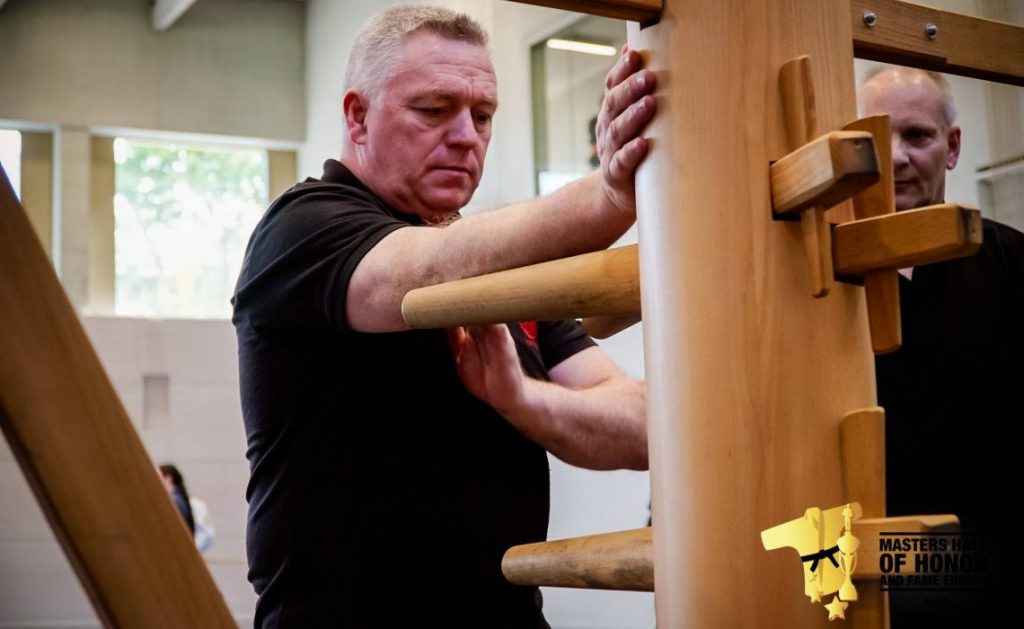
One of the primary advantages of wooden dummy training is the opportunity to practice techniques with a consistent and unyielding target. The dummy’s solid structure allows practitioners to execute strikes, punches, kicks, and maneuvers repeatedly, refining their form, accuracy, and power.
The wooden dummy also helps practitioners develop a heightened sense of positioning and control. By manipulating the arms and legs of the dummy, practitioners learn to maintain proper distance, control angles, and execute techniques with precision.
The wooden dummy also serves as a platform for practicing combinations and sequences. Practitioners can string together a series of techniques, transitions, and footwork patterns, creating fluid and seamless movements. This training method helps develop the practitioner’s ability to flow from one technique to another, ensuring efficiency and adaptability in combat situations.
Through consistent and dedicated training, practitioners develop a deep level of discipline and mental fortitude, which extends beyond their Wing Chun practice and permeates other areas of their lives.
Through consistent practice with the wooden dummy, practitioners improve their form, accuracy, timing, and adaptability. This training method enhances physical conditioning, fosters discipline, and deepens the practitioner’s understanding of the art.
Wooden dummy training is a fundamental aspect of Wing Chun that empowers practitioners to develop the necessary skills for effective self-defense and martial arts mastery.
Sparring and Realistic Application
Sparring and realistic application are critical components of Wing Chun training, allowing practitioners to put their skills to the test in dynamic and realistic combat scenarios.
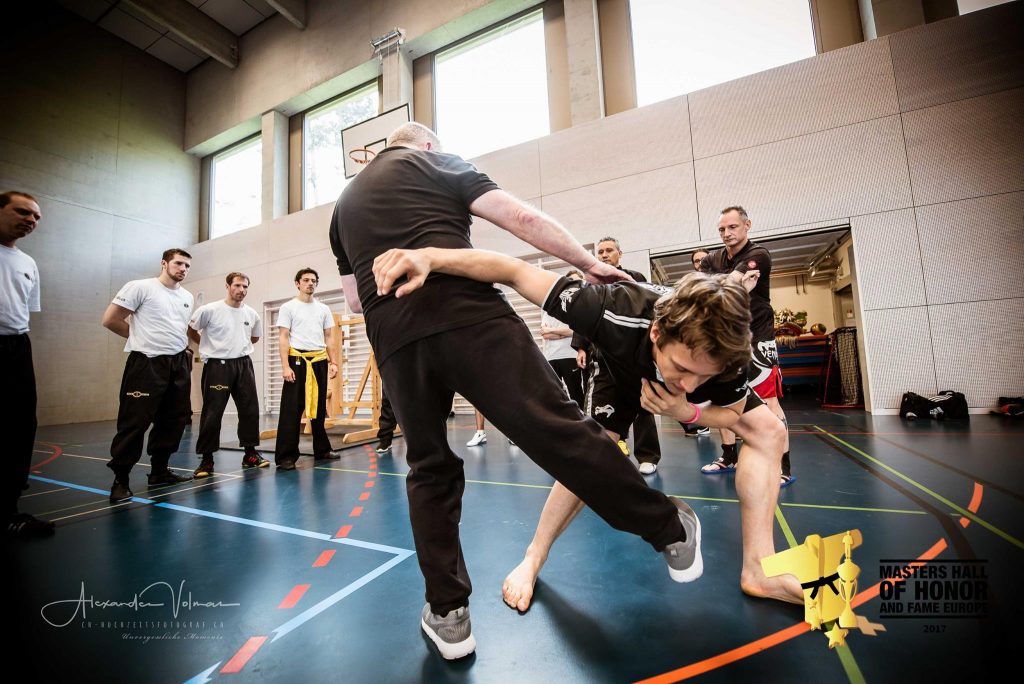
Sparring sessions in Wing Chun involve controlled and supervised combat simulations, where practitioners engage in exchanges with a training partner. These sessions aim to replicate real-life fighting situations while maintaining a safe and controlled environment. By engaging in sparring, practitioners develop the ability to apply their techniques under pressure and in real time, honing their reflexes and combat instincts.
One of the primary benefits of sparring is the opportunity to test and validate the effectiveness of techniques learned through forms and drills. It allows practitioners to understand the practical application of Wing Chun principles and techniques in a live situation. Through sparring, practitioners gain valuable insights into the timing, distance, and angles required for the successful execution of techniques.
Sparring cultivates the mental agility necessary for effective problem-solving in combat scenarios.
The intensity and physicality of sparring sessions push practitioners to exert themselves, improving cardiovascular fitness, muscular endurance, and stamina. It challenges practitioners to maintain composure and technique even when fatigued, mirroring the demands of real-life encounters.
It’s worth noting that while sparring focuses on realistic application, it still adheres to the core principles of Wing Chun, emphasizing efficiency, sensitivity, and control. Safety is paramount, and sparring sessions are conducted with proper protective gear and under the supervision of experienced instructors. The goal is to create a challenging yet supportive environment that promotes growth and development.
Sparring also plays a vital role in fostering camaraderie and a sense of community among Wing Chun practitioners. The mutual growth and development that occur during sparring sessions strengthen the bonds within the Wing Chun group.
By engaging in controlled combat simulations, practitioners gain valuable experience, refine their techniques, develop adaptability and decision-making skills, and enhance physical conditioning.
Personalized Training
One of the benefits of personalized training in Wing Chun is the ability to address individual strengths and weaknesses. Instructors can assess a practitioner’s skills, physical attributes, and areas of improvement, and then design training programs that target those specific areas. Whether it’s refining technique, improving flexibility, enhancing speed and power, or working on specific aspects of footwork, personalized training ensures that practitioners receive focused attention and guidance to progress effectively.

Moreover, personalized training accounts for variations in learning styles and aptitudes. Some individuals may excel in visual learning, while others may benefit more from hands-on instruction or verbal cues. Instructors can adapt their teaching methods and communication styles to cater to the diverse learning preferences of their students. This approach ensures that practitioners receive instruction in a manner that maximizes their understanding, retention, and application of the techniques and concepts.
Personalized training also accommodates the physical capabilities and limitations of each practitioner. Wing Chun can be practiced by individuals of different ages, body types, and fitness levels. Instructors can modify exercises, techniques, and training intensity to suit the specific needs and abilities of practitioners. This adaptability ensures that Wing Chun remains accessible and beneficial to individuals regardless of their physical condition or limitations.
Unleashing Your Potential through Tailored Training
In Wing Chun Kung Fu, one of the key factors that set it apart as a martial art is its emphasis on tailored training. By customizing training methods to suit the individual needs and goals of practitioners, Wing Chun enables them to unleash their full potential and achieve remarkable growth in their martial arts journey.
1. Assessing Individual Needs and Goals
Starting with an initial assessment, personalized training begins by understanding the unique needs, abilities, and aspirations of each practitioner. Instructors take the time to engage in open communication, listening to the practitioner’s goals and understanding their motivations.
2. Identifying Strengths and Areas for Improvement
Through careful observation and analysis, instructors identify the strengths and areas for improvement in a practitioner’s skill set. They pay attention to technical proficiency, physical attributes, and mental readiness. By pinpointing these aspects, instructors can design training routines that focus on enhancing strengths and addressing weaknesses.
3. Customizing Training Methods and Techniques
Tailored training involves customizing training methods and techniques to suit the individual practitioner. Instructors adapt teaching styles, instructional cues, and training modalities to cater to the practitioner’s learning preferences and aptitudes.
4. Setting Milestones and Tracking Progress
Personalized training involves setting realistic and achievable milestones based on the practitioner’s goals. Instructors break down long-term objectives into smaller, measurable steps that can be tracked and monitored. Regular assessments and progress evaluations provide feedback and allow for adjustments to the training program as needed.
5. Adapting to Individual Learning Styles
Everyone learns differently, and personalized training recognizes and accommodates diverse learning styles. Some individuals may thrive with visual demonstrations, while others may benefit from hands-on guidance or verbal explanations.
6. Emphasizing Individual Growth and Self-Expression
Tailored training empowers practitioners to embrace their individuality and express themselves through their martial arts journey. It encourages practitioners to explore their strengths, develop their unique fighting styles, and make the art truly their own.
7. Cultivating Confidence and Resilience
Personalized training nurtures the practitioner’s confidence and resilience by providing them with the tools and support necessary to overcome challenges and setbacks. Instructors guide practitioners through progressively more challenging training scenarios, pushing their limits and helping them build mental fortitude.
Tailored training in Wing Chun Kung Fu is a transformative experience that unleashes the practitioner’s full potential. By assessing individual needs and goals, identifying strengths and areas for improvement, customizing training methods and techniques, and adapting to individual learning styles, practitioners can experience accelerated growth and skill development.
FAQ Section
Q1: How long does it take to progress through the training levels in Wing Chun?
A: The time it takes to progress through the training levels in Wing Chun varies depending on individual dedication, frequency of training, and natural aptitude. Consistent practice, perseverance, and guidance from experienced instructors are key factors in progressing efficiently.
Q2: Can Wing Chun be learned by people of all ages?
A: Yes, Wing Chun is suitable for people of all ages. Whether you’re a child, adult, or senior, Wing Chun training can be adapted to accommodate different fitness levels and physical capabilities. It is important to communicate any specific concerns or limitations to the instructor to ensure a safe and personalized training experience.
Q3: Can Wing Chun be used for self-defense?
A: Absolutely. Wing Chun’s practical and efficient techniques make it a highly effective martial art for self-defense purposes. The focus on simultaneous attack and defense, close-quarters combat, and efficient movements empowers practitioners with practical skills to protect themselves in real-life situations.
Q4: Can Wing Chun help improve physical fitness and mental well-being?
A: Yes, Wing Chun training contributes to physical fitness, agility, and mental well-being. The practice involves dynamic movements, footwork, and striking techniques, which help develop strength, endurance, flexibility, and body awareness. Additionally, the mental focus, discipline, and stress relief gained from training can positively impact overall mental well-being.
Q5: How can I find a reputable Wing Chun school or instructor?
A: To find a reputable Wing Chun school or instructor, research local schools, read reviews, and consider visiting different schools to observe classes. Look for experienced instructors with a lineage traceable to reputable Wing Chun masters and inquire about their teaching methods, qualifications, and training philosophy.
